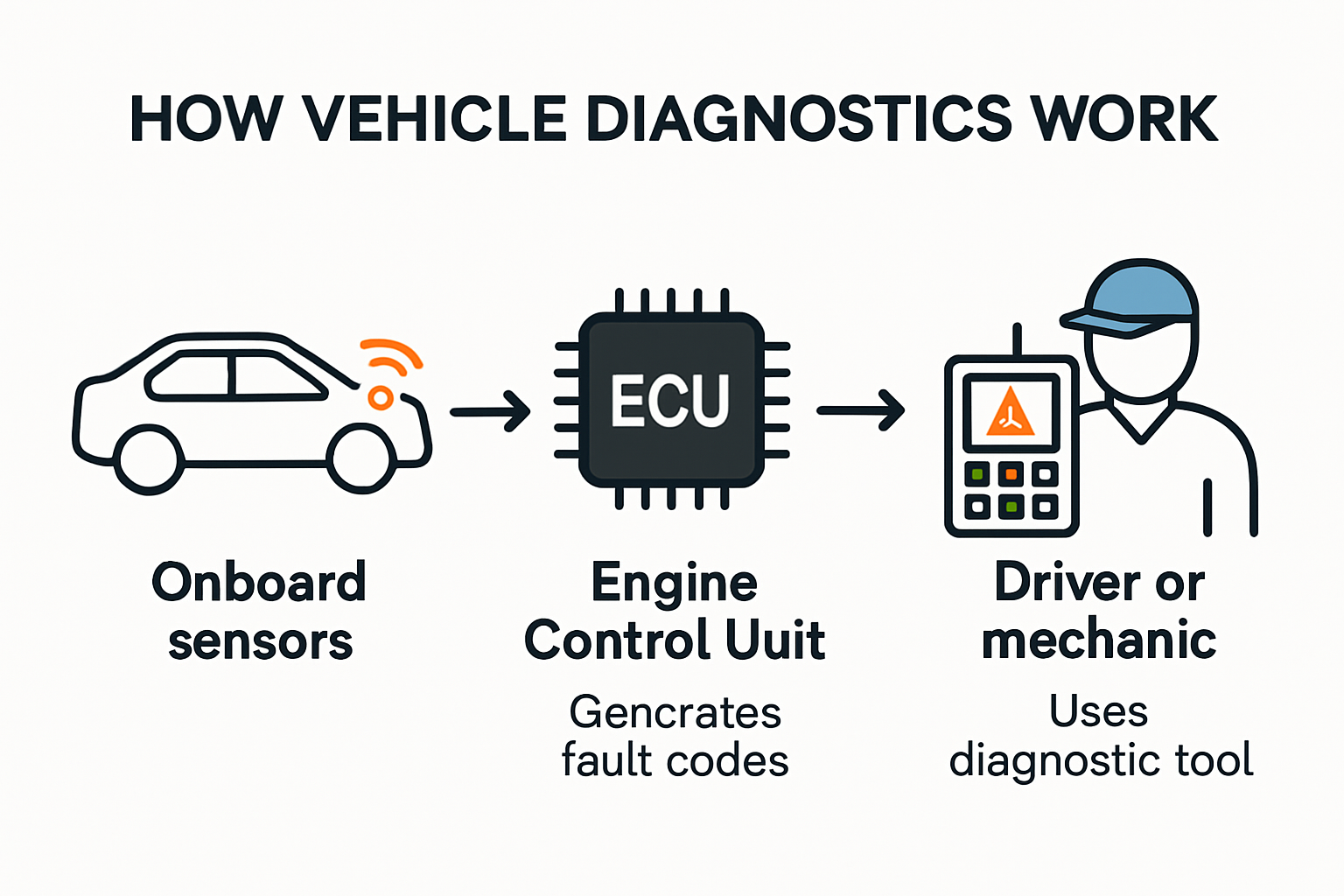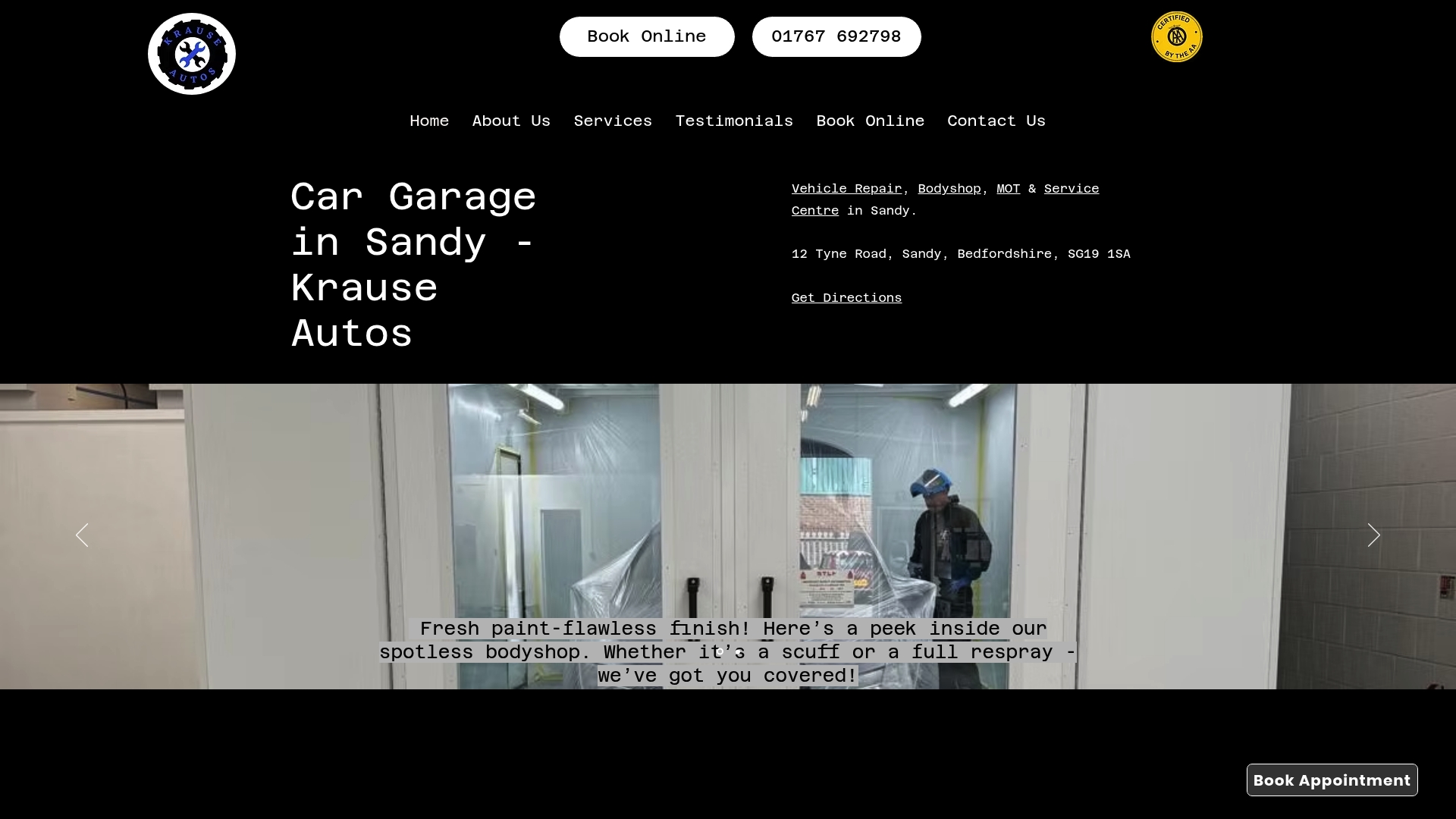Vehicle Diagnostic Basics 2025: Essential Guide for Every Driver
- coledem
- Jul 5
- 8 min read
Car dashboards now flash over 200 different warning lights and error codes in modern vehicles, turning even a short drive into a technical puzzle. Most people think these signals require a mechanic’s degree to make sense of. Actually, with the right approach and a few fundamental tricks, any driver can decode these messages and prevent breakdowns long before they start.
Table of Contents
Quick Summary
Understanding Vehicle Diagnostic Basics
Vehicle diagnostic basics represent a critical component of modern automotive maintenance, providing drivers with insights into their vehicle’s health and performance. In 2025, automotive diagnostics have evolved from simple mechanical checks to sophisticated digital assessments that can pinpoint issues with remarkable precision.
The Digital Heart of Modern Vehicle Diagnostics
Today’s vehicles are essentially complex computers on wheels, equipped with intricate onboard diagnostic (OBD) systems that continuously monitor vehicle performance. Explore our comprehensive guide on diagnostic checks to understand how these systems work. According to RAC automotive experts, modern diagnostic systems use advanced sensors and computer interfaces to track everything from engine performance to electrical system functionality.
The diagnostic process begins with the vehicle’s Engine Control Unit (ECU), which acts as the primary monitoring system. When an anomaly is detected, the ECU generates a specific fault code. These codes are standardised across manufacturers, allowing mechanics and vehicle owners to understand potential issues quickly. Fault codes provide a precise language that translates complex mechanical and electrical problems into readable information.

Interpreting Vehicle Diagnostic Signals
Warning lights on your dashboard are the most immediate form of diagnostic communication. Each light represents a specific system or potential problem. According to UK automotive standards, a systematic approach to diagnostics involves:
- Verifying the actual fault
: Confirming the warning is not a false signal
- Collecting comprehensive information
: Gathering all relevant data about the vehicle’s performance
- Conducting targeted tests
: Using specialised diagnostic tools to pinpoint exact issues
- Rectifying the problem
: Implementing precise repairs based on diagnostic findings
Modern diagnostic tools can now connect directly to a vehicle’s OBD port, allowing for real-time data collection and analysis. These tools range from basic code readers to advanced diagnostic computers that can provide detailed insights into a vehicle’s performance, electrical systems, and potential maintenance needs.
Understanding vehicle diagnostic basics empowers drivers to be proactive about their vehicle’s health. By recognising warning signs early and understanding the diagnostic process, you can prevent minor issues from developing into costly repairs. Regular diagnostic checks are no longer just a recommendation but a crucial aspect of responsible vehicle ownership in 2025.
Whether you’re dealing with a complex electrical issue or a simple sensor malfunction, understanding the fundamentals of vehicle diagnostics puts you in control of your vehicle’s performance and longevity.
Common Warning Signs and Error Codes
Modern vehicles communicate potential issues through a complex language of warning lights and error codes that can be critical for maintaining vehicle safety and performance. Understanding these signals is essential for proactive vehicle maintenance and preventing potential mechanical failures.
Decoding Dashboard Warning Lights
Dashboard warning lights are your vehicle’s primary communication method for signalling potential problems. Learn more about detecting electrical system issues to better understand these signals. According to By Miles automotive experts, different warning lights indicate specific system problems:
- Check Engine Light
: Signals potential issues with engine performance, emissions systems, or sensor malfunctions
- ABS Warning Light
: Indicates problems with the vehicle’s anti-lock braking system
- Battery Warning Light
: Suggests electrical system or charging problems
- Oil Pressure Warning
: Alerts drivers to potential lubrication system issues

Understanding Diagnostic Trouble Codes
Diagnostic Trouble Codes (DTCs) provide precise information about specific vehicle system problems. According to automotive diagnostic standards, these codes are standardised across vehicle manufacturers and offer detailed insights:
Common Error Code Categories:
- Powertrain Codes (P)
: Engine and transmission issues
- Chassis Codes ©
: Brake, suspension, and steering system problems
- Body Codes (B)
: Electrical and accessory system malfunctions
- Network Codes (U)
: Communication and computer system errors
Specific examples include:
P0101: Mass Air Flow Sensor Circuit Performance
C1234: ABS Wheel Speed Sensor Malfunction
B0011: Driver Airbag Deployment Circuit Issue
Professional Diagnostic Interpretation
While modern diagnostic tools can read these codes, professional interpretation remains crucial. Some error codes might indicate minor sensor issues, while others could signal significant mechanical problems requiring immediate attention. Not all warning lights demand emergency action, but ignoring them can lead to more expensive repairs.
Drivers should never ignore persistent warning lights or unusual vehicle behaviour. Modern vehicles are sophisticated machines with interconnected systems. A seemingly minor warning could indicate a potential major mechanical issue developing beneath the surface.
Regular diagnostic checks can help identify potential problems before they escalate. By understanding these warning signs and error codes, drivers can make informed decisions about their vehicle’s maintenance, potentially saving significant time and money in long-term repair costs.

To help readers quickly identify the meanings of common dashboard warning lights and typical trouble codes, the following summary table organises the most frequently mentioned signals.
How to Use Diagnostic Tools at Home
Home vehicle diagnostics have become increasingly accessible, empowering drivers to take a proactive approach to vehicle maintenance. Check out our comprehensive diagnostic tips to understand the basics of at-home vehicle diagnostics. Modern technology has transformed the way drivers can monitor and understand their vehicle’s health, making sophisticated diagnostic tools more user-friendly than ever before.
Selecting the Right Diagnostic Tool
Choosing an appropriate diagnostic tool is crucial for effective home vehicle checks. According to UK National Occupational Standards, there are several types of diagnostic tools available:
- Basic Code Readers
: Entry-level devices that read and clear basic error codes
- Advanced OBD-II Scanners
: Provide more detailed diagnostic information
- Smartphone-Connected Diagnostic Tools
: Offer real-time data and app-based analysis
- Professional-Grade Diagnostic Computers
: More comprehensive but typically more expensive
When selecting a tool, consider your vehicle’s make, model, and your technical expertise. Prices range from £20 to £500, with most home users finding mid-range tools between £50 and £150 most suitable.
Step-by-Step Diagnostic Process
Below is a step-by-step table summarising the home diagnostic process for readers wanting a quick reference.
Important safety considerations include:
Always read the tool’s manual carefully
Ensure the vehicle is in a safe, stationary position
Disconnect the tool properly after use
Do not attempt repairs beyond your skill level
When to Seek Professional Help

While home diagnostics are valuable, they are not a complete replacement for professional vehicle maintenance. Some complex issues require specialized knowledge and equipment. Warning signs that indicate you should consult a professional include:
Persistent warning lights after running a diagnostic
Codes indicating serious system failures
Complex electrical or mechanical error messages
Any diagnostic result you do not fully understand
Home diagnostic tools provide an excellent first line of defence in vehicle maintenance. They offer insights into your vehicle’s health, help you understand potential issues early, and can save money by identifying problems before they become serious. However, they should be viewed as a complement to, not a replacement for, professional automotive expertise.
Remember, while technology has made diagnostics more accessible, the complexity of modern vehicles means that some issues require professional intervention. Use your home diagnostic tools as a helpful monitoring system, but always prioritize safety and professional advice when needed.
Expert Tips to Prevent Costly Repairs
Preventing expensive vehicle repairs requires a proactive approach to maintenance and understanding your vehicle’s unique needs. By implementing strategic care practices, drivers can significantly reduce the likelihood of unexpected and costly mechanical failures.
Regular Maintenance Fundamentals
Learn about essential car repair strategies to protect your vehicle’s long-term performance. According to RAC automotive experts, adhering to the manufacturer’s recommended service schedule is crucial for maintaining engine efficiency and preventing major mechanical issues.
Key maintenance practices include:
- Oil and Filter Changes
: Perform at recommended intervals
- Brake System Inspections
: Check brake pads, rotors, and fluid levels
- Tyre Maintenance
: Rotate tyres and check pressure regularly
- Fluid Level Checks
: Monitor coolant, transmission, and brake fluids
Daily Vehicle Care Strategies
According to Health and Safety Executive guidelines, daily vehicle checks can prevent potential breakdowns and expensive repairs. The recommended daily inspection routine includes:

- Tyre Condition
: Check for proper inflation and signs of wear
- Lights and Indicators
: Verify all exterior lights are functioning
- Windscreen and Wipers
: Inspect for cracks or damage
- Unusual Noises or Vibrations
: Listen for any unexpected sounds
Northern Ireland Direct emphasises that maintaining correct tyre pressures not only enhances safety but also prevents premature wear, potentially saving hundreds of pounds in unnecessary replacements.
Advanced Preventative Maintenance
Beyond routine checks, advanced preventative maintenance involves:
- Diagnostic Monitoring
: Use home diagnostic tools to catch early warning signs
- Environmental Considerations
: Protect vehicle from extreme temperatures
- Driving Habits
: Avoid aggressive driving and sudden acceleration
- Storage Practices
: Use appropriate covers and maintain proper storage conditions
Professional mechanics recommend keeping a detailed maintenance log. This documentation helps track your vehicle’s health, identifies potential issues early, and can be valuable when selling the vehicle.
While these strategies require time and occasional investment, they are significantly more cost-effective than major repairs. A proactive approach to vehicle maintenance can extend your car’s lifespan, maintain its performance, and protect your financial investment.
Remember, prevention is always more economical than cure. By investing a little time and effort in regular maintenance, you can avoid the stress and expense of unexpected major repairs, ensuring your vehicle remains reliable and efficient for years to come.
Frequently Asked Questions
What does the Check Engine Light mean?
The Check Engine Light signals potential issues with engine performance, emissions systems, or sensor malfunctions. It’s important to run diagnostics to determine the exact cause.
How can I use diagnostic tools at home?
To use diagnostic tools at home, connect the tool to the OBD-II port of your vehicle, turn on the ignition, and run a diagnostic scan. Follow your tool’s user manual for detailed steps.
When should I seek professional help for vehicle diagnostics?
You should seek professional help if warning lights persist after running diagnostics, if you receive codes indicating serious system failures, or if you don’t fully understand the diagnostic results.
What are some common Diagnostic Trouble Codes (DTCs)?
Common DTCs include P0101 for a mass air flow sensor circuit performance issue, C1234 for an ABS wheel speed sensor malfunction, and B0011 for driver airbag deployment circuit issues.
Get Ahead of Vehicle Troubles with Trusted Diagnostics in Bedfordshire
Modern vehicles can feel overwhelming with their 200 warning lights and complicated error codes. As highlighted in our essential guide, recognising early signs and understanding diagnostic signals is key to saving money and keeping your car safe. Many drivers worry about whether those warning lights mean a quick fix or a costly breakdown. If you are unsure how to interpret dashboard alerts or want peace of mind before small issues become expensive, local expertise can make all the difference.
Bring your vehicle to Krause Autos for comprehensive diagnostics, honest advice, and repairs you can rely on. Our Sandy-based team uses advanced tools to accurately identify mechanical, electrical or bodywork concerns that others might overlook. We care for all makes and models and are trusted throughout Bedfordshire for integrity and transparency. Visit Krause Autos today to book your diagnostic check and discover true local service. Take control of your car’s health before that next warning light turns into something bigger.
Recommended
- Car Diagnostic Check Guide 2025: Essential Tips for UK Drivers
- Car Electrical Faults Explained: Easy Guide for Every Driver 2025
- Car Electrical System Basics: Easy Guide for All Drivers 2025
- Why Regular Car Service Matters in 2025: Essential for Every Driver
- Car Warranty and Repairs: Your 2025 Guide for Every Driver
- Choosing a Local Garage in 2025: A Guide for Everyday Drivers





Regular diagnostics aren’t just about fixing problems they’re key to preventing costly repairs and keeping your car running at peak performance. If you’re looking for expert diagnostic services, Torrance Motors offers professional checks and repairs tailored to your vehicle’s needs. You can learn more at Torrance Motors.